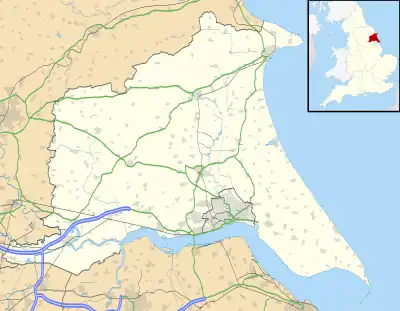RAF Lissett | |||||||||||||||||||
|---|---|---|---|---|---|---|---|---|---|---|---|---|---|---|---|---|---|---|---|
| Summary | |||||||||||||||||||
| Airport type | Royal Air Force station | ||||||||||||||||||
| Owner | Air Ministry | ||||||||||||||||||
| Operator | Royal Air Force | ||||||||||||||||||
| Location | Lissett, East Riding of Yorkshire | ||||||||||||||||||
| Built | 1940 | ||||||||||||||||||
| In use | 1943-1947 | ||||||||||||||||||
| Elevation AMSL | 16 ft / 5 m | ||||||||||||||||||
| Coordinates | 54°00′19″N 000°16′23″W / 54.00528°N 0.27306°W | ||||||||||||||||||
| Map | |||||||||||||||||||
 RAF Lissett Location in East Riding of Yorkshire | |||||||||||||||||||
| Runways | |||||||||||||||||||
| |||||||||||||||||||
Royal Air Force Lissett or more simply RAF Lissett is a former Royal Air Force station located 6.1 miles (9.8 km) south west of Bridlington, East Riding of Yorkshire, England.
History
Originally required as satellite airfield for RAF Catfoss the land was requisitioned in 1940. Although constrained by three roads and the Gransmoor Drain the builders constructed a standard three-runway bomber airfield. It had two hangars and 36 dispersals and three concrete runways.
Lissett opened in February 1943 and No. 158 Squadron RAF arrived from RAF Rufforth to be the resident squadron on 28 February. 158 Squadron was a heavy bomber squadron equipped with the four-engined Handley Page Halifax. The squadron flew the first operational mission on the night of 11/12 March 1943 when ten aircraft were flown to Stuttgart. One aircraft failed to return. The squadron carried out operations up to the end of the war from Lissett. Apart from a few weeks in early 1944 only 158 Squadron operated out of the station, which was unusual for an RAF base. Over the course of the 2 years 158 Squadron was stationed there they completed 250 missions, suffering the loss of 144 aircraft, either destroyed in combat or in accident. In addition, 851 of the squadron's airmen were lost in the war.[1]
In May 1945 with the war at an end the squadron re-equipped with transport aircraft and was transferred to Transport Command. The squadron flew early-war four engine Short Stirling bombers before departing to RAF Stradishall in August 1945. With the departure of 158 Squadron the station was relegated to a care and maintenance status but by the end of the year the airfield was abandoned and the technical areas used for storage.
Based units
| Unit | Aircraft | Variant | From | To | To | Notes |
|---|---|---|---|---|---|---|
| No. 158 Squadron RAF | Handley Page Halifax Short Stirling |
II/III/VI V |
28 February 1943 | 17 August 1945 | Stradishall | Four-engined heavy bombers |
| No. 1484 Flight RAF | Boulton Paul Defiant Armstrong Whitworth Whitley Miles Martinet |
I | 1944 | 1944 | January and February 1944, target towing and gunnery training | |
| No. 14 Maintenance Unit | N/A | 1945 | 1947 | Elvington | Sub site | |
| No. 91 Maintenance Unit | N/A | 1945 | 1947 | Acaster Malbis | Sub site |
Current use

In December 2008 a wind farm housing 12 turbines (Nordex N90's)[5] each standing 100 metres (330 ft) high was constructed on the western end of the airfield.[6][7]
A memorial metal sculpture to 158 Squadron in the form of seven airmen representing the typical crew of a Halifax bomber, was erected on the base and dedicated to the memory of the 851 airmen who did not return from operations at the airfield. The monument is situated on the edge of the old airfield site on Gransmoor Road, Lissett.[1][8]
References
Citations
- 1 2 "A new Memorial to 158 Squadron stationed at RAF Lissett". 158 Squadron Association. Retrieved 7 August 2017.
- ↑ Jefford 1988, p. 158
- ↑ Sturtivant 2007, p. 124
- ↑ Delve 2006, p. 185
- ↑ "Nordex awarded new contracts for 55 MW: UK customer ordering five wind farms from Nordex". Nordex SE. 14 May 2012. Retrieved 22 April 2013.
- ↑ "Lissett Airfield Wind Farm". forgottenairfields.com. 4 December 2008. Retrieved 4 November 2009.
- ↑ See also Forces TV video "Declassified:What Happened To These RAF Bases Since WW2?" https://www.youtube.com/watch?v=_Os0Fbt0C2M at 20:35
- ↑ Latitude 54° 0'40.11"N Longitude 0°15'37.98"W in Google Earth
Bibliography
- Delve, Ken (2006). The Military Airfields of Britain – Northern England. The Crowood Press. ISBN 1-86126-809-2.
- Jefford, C.G. (1988). RAF Squadrons. Airlife Publishing Ltd. ISBN 1-85310-053-6.
- Sturtivant, Ray (2007). RAF Flying Training and Support Units (Since 1912). Air-Britain Historians Ltd. ISBN 978-0-85130-365-9.
